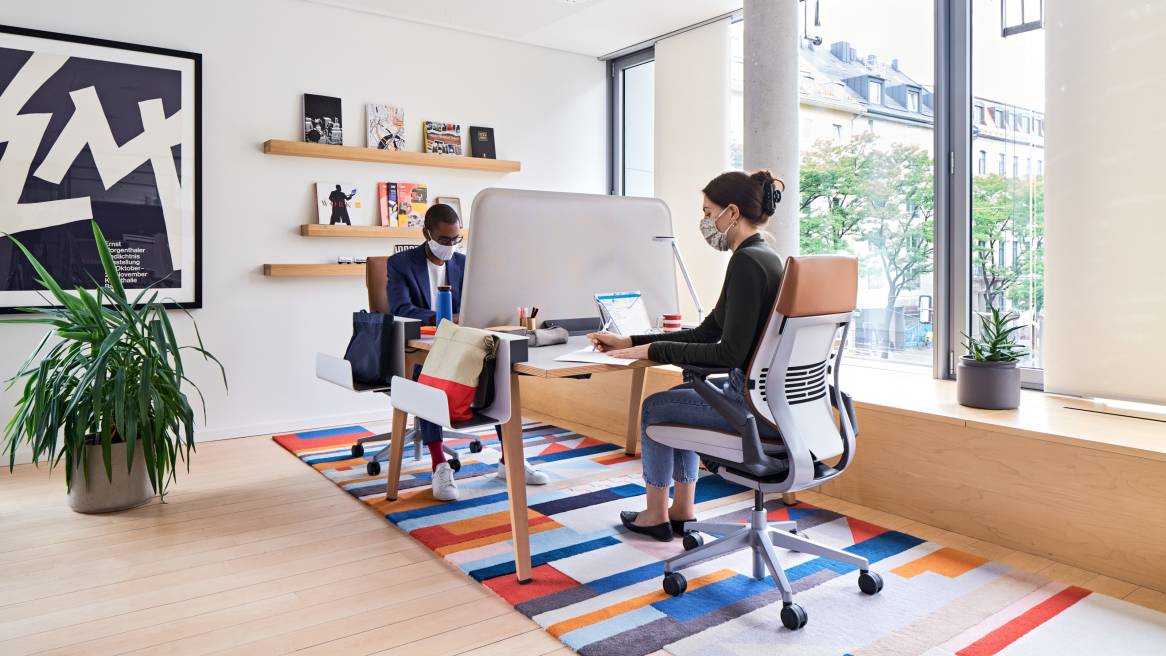As governments gradually relax stay-at-home restrictions, organisations are planning and starting to welcome their employees back into the office. Agility is vital, says the team of leaders at Steelcase who were charged with the responsibility of developing strategies to address the unprecedented dynamic global crisis. “We’re all dealing with something new and learning every day,” says Sara Armbruster, vice president, strategy. Armbruster is leading the cross-functional core team responsible for Steelcase’s overall global COVID-19 response. “The global pandemic has created this massive and complex systems problem that has impacted everything — people, places, buildings, travel, almost every interaction we have with other people. It’s impossible to look at only one piece of that system to make decisions.”
A User-Centered Design Approach
Organisations are making choices about the speed at which they can bring people back to the workplace – and they’re doing this with a much greater emphasis on employee wellbeing and safety. According to Armbruster, Steelcase is deploying a user-centered design approach, like the one it uses in its innovation practice, to address the problem. “We believe it’s critical to get employees back to the workplace – work is a social activity and the office is where employees have access to the people and tools they need to collaborate most effectively and to generate new ideas that lead to innovation. So, we are actively preparing ourselves and helping our clients prepare for the return to the office. We’re thoughtfully considering all the components of the situation and the needs of all stakeholders before we develop a point of view,” she says.
For weeks, her team has been meeting daily to work through issues as they arise. Time horizons have been dramatically shortened. “We no longer see things in sprints of weeks or even days,” says Armbruster. “We quickly realized there are decisions we need to align around as a cross-functional team every single day. The decisions we’re trying to make, the speed at which we’re trying to move, and the global scope of how we’re trying to communicate and make choices has required us to work differently.”
The Steelcase COVID-19 team has devoted much of its time and energy staying abreast of the latest information from health experts and organizations such as the Centers for Disease Control (CDC) in the United States and World Health Organization (WHO) to better understand how the disease is transmitted and how to make the workplace as safe as possible at a time when there are many unknowns. “Our goal has been to develop a science-based response whenever possible,” says Armbruster. “This helped us guide the Steelcase strategy using global principles that can be customized at local levels, where laws and policies differ.”
How Employees Feel
In preparation for the return of our people, Steelcase conducted surveys, as well as employee round tables, to get a pulse on employee sentiment. “Our employees have never experienced a global crisis of this magnitude, and we didn’t know how people are feeling,” says Jill Dark, director, leadership & talent transformation. “It’s important that we understand people’s concerns and their motivations for returning to the office. We needed to make decisions that impact our employees and we wanted them to have an opportunity to provide input into those.”
According to Dark, in crisis, people are hardwired to make decisions that minimize threats. This can lead to decisions based more on emotion than logic. We wanted data to drive our decisions. The surveys measured employees’ readiness and speed to return to the office. We saw a high response rate (almost 67%) for a non-mandatory survey,” says Dark. Employees really care about this issue and we learned it’s a polarizing topic.”

Readiness To Return
The results at Steelcase break down into roughly thirds: one third of employees are eager to return to work the first week they can. Another third is uncertain about when they might return and one-third is hesitant to return, often due to underlying health concerns for themselves or a family member. Those eager to return were craving social connections and the tools that an office gives people, such as ergonomic office seating, height-adjustable desks, large-scale collaboration technology, whiteboards and printers.
According to Dark, the workplace that people return to will have to be a “very different and changed place. One thing that won’t change is the need for people to connect to the organization’s purpose and to feel a sense of belonging that may have been strained while working remotely,” she says. “Being in the office is a tangible way to meet that need; so, we strive to find ways to do so safely because employees told us they need more certainty before they return. Organizations will need to create a workplace where people feel safe.”
The Steelcase “return to the workplace team” decided it would take a strong position on safety from the start and relax it later, if the conditions and the science-based evidence allow.
As a result, the Steelcase “return to the workplace team” decided it would take a strong position on safety from the start and relax it later, if the conditions and the science-based evidence allow, explains Dark. “No employer wants to become a source of an outbreak. People have to feel their company has done everything possible to keep them safe before they will return,” she says.
For this reason, and based on governmental recommendations, Steelcase decided to make face coverings mandatory for the initial return to the office. While some employees who are unaccustomed to this practice have expressed hesitation, Dark says that the company has learned from operations teams who have already returned that “the first four days are the hardest and then people get used to the face coverings.”
As of late May, the first wave of employees have been invited to return to the office in Munich, closely followed by Madrid, Paris and London.
New Protocols + Behaviors
To create the safest environment possible, Steelcase has introduced protocols that have become standards for many organizations to encourage new behaviors:
- Face coverings are mandatory for employees and guests while in shared environments and in individual environments when the ability to stay at least 6 ft/2 m away from others cannot be achieved. Face masks will also be required depending on factors such as the degree of enclosure and the nature of the air circulation. These were made available to employees at the entrance on their return.
- All employees must complete an online pre screening health questionnaire prior to arriving to work and have an on-site temperature check to indicate they are symptom free.
- We’ve also implemented many of these same protocols and behaviors across our global manufacturing facilities.
Smart + Connected: A Data-Based Approach to Cleaning
Cleaning is a critical component for mitigating the spread of disease and the Steelcase facilities team is taking a strategic approach to address the issue. To help identify the spaces that are the most utilized and likely to require deeper and more frequent cleaning, data from Steelcase Workplace Advisor – a sensing and space analytics management system – is being used to identify frequently used spaces within facilities.
“This data is critical in helping us identify highly-utilized spaces and determine where we need to intensify cleaning protocols,” says Dan White, director, global facilities and real estate. The company has also added sanitation caddies throughout the campus, so employees can self-clean spaces before and after use. Additional cleaning staff has been hired to disinfect high traffic areas throughout the day. “We’re committed to keeping the office as clean as possible and visibly reassure our employees that sanitation is a priority,” says White.
Physical Changes: Density + Geometry + Division
An audit of all spaces was done to identify changes required to meet social distancing guidelines. To create the necessary six foot/2-meter distance and decrease density, furniture was pulled further away from each other where possible or removed completely. “In areas where we have products like the Steelcase Flex Collection, we didn’t have to do very much. The product is very mobile, and employees can make changes themselves to increase the distance or change the orientation (geometry) of their desks.”
“In areas where we have products like the Steelcase Flex Collection, we didn’t have to do very much. The product is very mobile, and employees can make changes themselves to increase the distance or change the orientation of their desks.”
Temporary cardboard screens (developed specifically for this situation and available for our customers) and the use of Steelcase separation screens have been added to create additional division in areas where the six foot/two-meter distance could not be achieved. Some workstations have been marked with signage to communicate the space should not be used. “In meeting and project rooms we removed 50% of the seating and are providing people with social distancing sticks to remind them not to get too close to each other,” says White.
Visual cues on walls and floors remind people to stay at a distance as well as indicate recommended traffic patterns in busy corridors to avoid face-to-face contact. And, the company is also accelerating its investment to replace devices with touchless experiences (i.e. faucets, soap dispensers, bottle filling stations, etc.) and making changes to the HVAC systems as needed to improve ventilation.
Communication + Transparency
Ongoing, frequent communication is key to successfully bringing people back to the office. People need to understand what they’ll be coming back to and what the expectations are. “There is no such thing as over communicating in this situation,” says Katie Woodruff, manager, corporate communications. “You have to be really transparent about what you’re doing, why and how you’re doing it.”
Upon their return, all employees will receive an employee handbook and attend an orientation session. But communication began months ago – before people were sent home. Employees have been receiving daily video messages and blogs to keep everyone up-to-date on how the company is responding to the crisis. Former CEO Jim Keane has frequently used video to speak directly to employees and give them updates on the business, our plan and our actions. The company also created an employee wellbeing channel on its intranet, as well as tips on how to lead people and teams in turbulent times.
“During an ongoing global crisis, the situation is evolving daily and we try to respond quickly as we learn, in the moment. We don’t have all the answers,” says Armbruster. “But like most organizations, we’re on a journey — and we’re learning every day to make the best possible choices for our people and our company in a time of uncertainty. ”
Download the Guide
To see design considerations and thought starters, download the complete guide, Navigating What’s Next: The Post-COVID Workplace.
hbspt.forms.create({
portalId: “1822507”,
formId: “65979703-7f12-4822-9a63-104cadf304ff”
});


